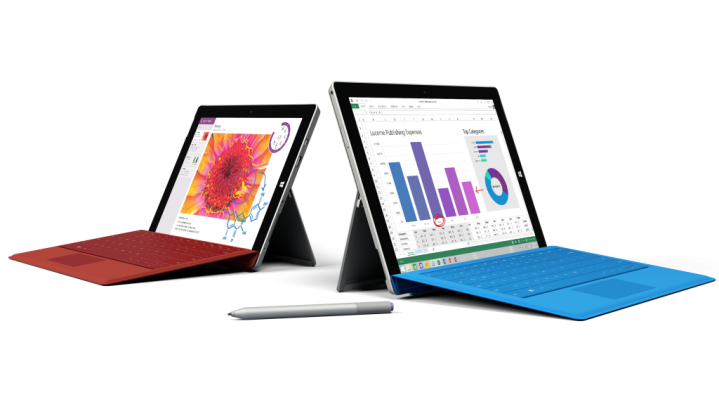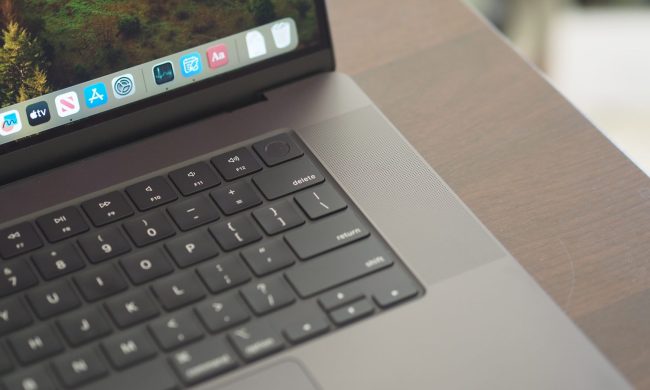
Their form factors may be similar, but their performance and specs are quite different. If you can’t decide which is the right one for you, this is a great place to start.
Microsoft Surface 3 |
Microsoft Surface Pro 3 |
|
| Size | 10.52 x 7.36 x .34 (in) | 11.5 x 7.93 x .36 (in) |
| Weight | 1.37 lbs | 1.76 lbs |
| Screen | 10.8-inch multitouch | 12-inch multitouch |
| Resolution | 1920 x 1280 pixels | 2160 x 1440 pixels |
| OS | Windows 8.1 | Windows 8.1 |
| Storage | 64/128GB | 64/128/256/512GB |
| SD Card Slot | MicroSD | MicroSD |
| Processor | Quad-core Intel Atom x7-Z8700 | Intel Core i3/i5/i7 |
| Base/Turbo clock | 1.6/2.4GHz | 1.5/1.9/1.7GHz |
| RAM | 2/4GB | 4/8GB |
| Connectivity | 802.11ac Wi-Fi, LTE (optional) | 802.11ac Wi-Fi, LTE (optional) |
| Camera | Front 3.5MP, Rear 8.0MP | 5MP front and rear |
| Bluetooth | Yes, version 4.0 | Yes, version 4.0 |
| Sensors | Ambient light, proximity, accelerometer, gyroscope, magnetometer | Ambient light, accelerometer, Gyroscope, Magnetometer |
| Ports | USB 3.0, Mini DisplayPort, 3.5mm headset | USB 3.0, Mini DisplayPort, 3.5mm headset |
| Battery | 10 hours quoted | 9 hours quoted |
| Charger | Micro USB | Proprietary |
| Marketplace | Windows Store | Windows Store |
| Ave. Price | $500 | $800 |
| DT Review | 3.5 out of 5 stars | 3.5 out of 5 stars |
Design
They’re both from the same family, and they both have the same issues when it comes to design.
Compared to other tablets, both the Surface and Surface Pro 3 are a bit heavier, coming in at 1.37 and 1.76 lbs respectively. A lot of tablets come in at under a pound, including the iPad Air line and the Lenova Yoga Tablet 2.
Battery life is a bit lacking too, when you compare them to other competing tablets. The Surface 3 gets about six hours and 30 minutes on a single charge, and the Surface Pro 3 comes in around eight or nine hours. That’s pretty decent for a laptop, but we’ve come to expect our tablets to take us a bit further before running out of juice.
Winner: Tie
Performance
Performance is still a bit lacking, and especially on the Surface 3, multi-tasking can drag the system down. When you compare it to other notebooks in its price range, like the Asus T300 Chi, the Surface 3 lags way behind in terms of raw speed and power. You’ll want to make sure to get the version of the Surface 3 with four gigabytes of RAM if that’s the device you’re leaning towards, as two gigabytes really isn’t enough for Windows 8.1.

The Surface Pro 3 is a bit speedier than the regular Surface 3, but it still doesn’t quite match the performance of a dedicated laptop. Multi-tasking is much improved. 3D games, on the other hand, remain too much for the Pro to handle.
Winner: Surface Pro 3
Display
Beautiful displays are a strength of the third generation of Surface devices. The Surface 3’s screen is a 10.8″ 1920×1280 display, which gives it a decent pixel density of 213 ppi. It’s bright though, and has accurate color representation that makes it really enjoyable to use as a laptop.
The Surface Pro 3’s 12″ display has an even higher resolution of 2,160 x 1,440, putting it at 216 ppi, just slightly higher than the 3. Both devices have a 3:2 aspect ratio.
Multi-touch support is essential on the Surface and Surface Pro 3, since the tablet functionality is a big part of the appeal. The stylus available for both devices is a highlight, with 256 levels of sensitivity and handwriting recognition.

Winner: Tie
Price
For both the Surface 3 and Surface Pro 3 devices, price is a big sticking point. the Surface 3 starts at $500, but we highly recommend the upgrade to the $600 version with twice the RAM and storage. The Pro version starts at $800, but the step up to an Intel Core i5 with more RAM and storage can easily get you over $1000. That’s not a particularly steep price, but the extras are going to cost you.
The most standout feature of the Surface line is the ability to attach a keyboard and use it as a laptop, but in order to do so, you need to buy the keyboard. Regardless of which version you go with, the keyboard is going to run you $130. It acts as a cover too, but that doesn’t warrant such a high price tag.
Winner: Surface 3
Conclusion
Ultimately, the scalability of these systems means that your needs are going to determine which you go with. However, both systems suffer from similar issues – lackluster performance and short battery life. Unless the convertible form factor and the convenience of only carrying around one device is really important to you, neither device warrants the high price tag.
That’s why the Surface 3 comes away with the win. Even when you upgrade the internals and pick up a keyboard case, it’s about the same price as a lower-end laptop and a budget Android tablet. The Surface Pro 3’s price point is just too high. For what you pay, you could easily buy a decent laptop and an iPad.
Winner: Surface 3







